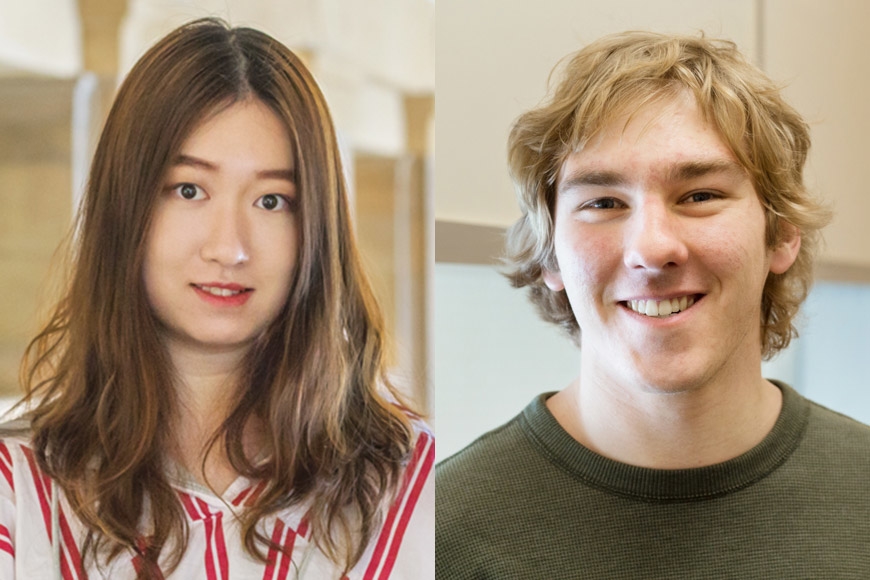Building A Stronger Community through Statistics
The College of Liberal Arts is the largest college on the University of Minnesota Twin Cities campus. In fact, it’s the largest college in the the state. Because it’s so large, it can be hard to feel a sense of belonging. Even within their respective college and major, students can feel lost and insignificant among the thousands of other students.
The College of Liberal Arts recognizes that it must work even harder to build community among its students. First-Year Experience (FYE), CLA’s program dedicated to first-year students and their transition into college life, takes on that task. Through a research project with FYE, statistics seniors Sabrina Li and Ryan Lerch looked at how different demographics affect a first-year student’s sense of belonging. For their purposes, they defined belonging as a perception of similarity between oneself and one’s surrounding community.
Gathering The Data
Li didn’t always know she wanted to major in statistics. In fact, she studied business until her sophomore year. “I realized I wanted something focused on hard skills rather than soft skills,” Li says. She is also minoring in computer science and math, combining statistics and programming.
In her junior year, Li applied to intern with First-Year Experience and was hired even before the interview. Participating on an analytics team of five other students, Li worked as a data analysis intern. The team’s goal was to answer the question: what background demographics are related to a first-year student’s sense of belonging?
Utilizing the first-year online classes CLA 1001 and 1002, the team sent out surveys to get feedback on students’ feelings, progress, and sense of belonging in college. Li’s job was to impute missing responses to create a complete data set. By using several models and target values, she had a 91% accuracy rate on imputing the missing responses.
As a member of the International Student & Scholar Services here on campus, Li was particularly interested in international students’ sense of belonging. “We found that international students have a harder time getting involved compared to students from the US,” she says. The metrics used to evaluate a student’s sense of belonging range from involvement on campus, stress levels, their intended major, and overall satisfaction with college.
In order for the team to examine student demographics, each student has an individual ID. The team only knows their ID, not their name, and is able to track the student’s progress throughout the school year to see if their sense of belonging is improving.
Diving Deeper Into Demographics
Senior Ryan Lerch had already been involved with First-Year Experience as a section leader, interacting closely with first-year students and helping them with the transition into college life. This year, he became involved with the same analytics team Li is on. “This was a really cool opportunity because there had never been a longitudinal study conducted among first-year students,” Lerch says.
After Li imputed the missing responses, Lerch’s job was to analyze and make meaning of it. “Raw data is rarely in a conducive format,” Lerch adds, noting how difficult it can be to find meaning in large amounts of data. By fitting models to the responses, Lerch was able to determine which demographics most affected a first-year student’s sense of belonging.
Upon analysis, Lerch found that gender was an insignificant factor in whether a student felt like they belonged. He also found that sexuality played a role in sense of belonging; heterosexual students have a stronger sense of it than nonheterosexual students. Race was the most significant factor he analyzed. “Students of all races felt an equal sense of belonging except students who identified as African American,” Lerch notes. Participation in the FYE class also affected it, finding that students who engaged with the course and received higher scores in it generally reported they felt a higher belonging.
Lerch and the team also looked at how students’ sense of belonging progressed over time and whether or not their major certainty, participation in the course, or overall feelings toward college affected it. “We found that students felt the strongest sense of belonging in the first week of college after Welcome Week,” Lerch says. “We attribute this to a sort of honeymoon phase where students are still excited about the novelty of being in college.”
Another important finding is that not all students’ sense of belonging unilaterally decreased from the beginning to the end of the semester. “These results were rather unsurprising but still useful because they supported our notions of first-year students,” Lerch says.
Next Steps
Fostering a sense of belonging can be difficult, but both Li and Lerch are confident their findings can be used to make change. “For international students, I think it’s important to not let them realize they’re different,” Li says. “I think this will help them feel a stronger sense of belonging.” More diversity in the course’s activities and an increased visibility of resources are a few more of her ideas.
“Our findings highlighted the necessity of our program to focus on engagement efforts right away so we can get students as engaged as possible,” Lerch adds. The analytics team plans on sitting down and further discussing the implications of their findings and how First-Year Experience can incorporate them into their program.
As seniors who feel a strong sense of belonging, this project really hit home for both Li and Lerch. Looking ahead to the future, they feel well-equipped for what is to come.
Li has applied to several graduate programs and hopes to work in data science or applied statistics. Lerch wishes to gain more internship experience and is considering graduate school further down the road. He hopes to end up in South Korea where he can combine his statistics background and his Korean minor in a job.
This story was written by an undergraduate student in CLA.



